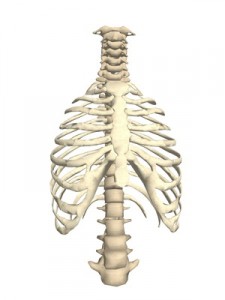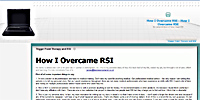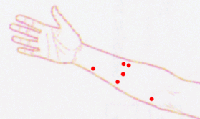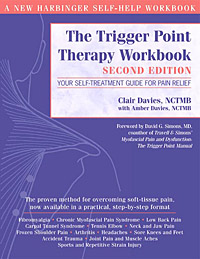 It’s time I revisited my previous costochondritis posting as it has been a while since I posted it and its well overdue an update.
It’s time I revisited my previous costochondritis posting as it has been a while since I posted it and its well overdue an update.
It has been over 4.5 years since I was first diagnosed with costochondritis in my sternum after heavy labour in the garden. It has certainly proven to have been a very long drawn out recovery. The recovery seems to go on like a logarithmic decay graph with a never-ending tail.
The main symptoms vary between achy pain in the sternum area (a bad flare up) and a very itchy, achy feeling that actually results in a lot of scratching!
For a long time I had been getting on with life, but with a lot of pre-planning of my activities around what I could do (without triggering a flare up) and apportioning accordingly. The activities I knew would strain the chest more I either put off or scheduled for another time when I would be less busy. Its all been about pain (and itch) flare up management over the last 4+ years.
I started off by using Devil’s Claw (as I couldn’t use ibuprofen due to stomach irritation), taking two capsules once a day. This helped reduce the symptoms to a certain level, but I stopped taking it about a year ago due to other side effects. I had also used (and still do) a pillow to ‘hug’ in bed every night which keeps the sternum area from compressing in on itself, allowing it to rest and heal.
The problem with this condition is the lack of blood supply to the sternum area and hence the long, drawn out healing time.
I am a physically active person. I kayak a lot, I do cardio workouts on a static bike and an elliptical trainer and I also do yoga. I have generally found these activities to be tolerable with costochondritis (except for the arm action on the elliptical which I sometimes have to forego). I have to take it easy with certain yoga poses, again scheduling practice around other activities to avoid overuse. I always found kayaking to be quite beneficial, but didn’t really know why. I assumed that it just wasn’t straining the chest area.
At the start of 2013 I was still having bouts of itchy costochondritis and was getting quite fed up with it. I visited my GP and mentioned to him that I still had this itch going on and he advised me to continue with physiotherapy exercises (which I admittedly hadn’t been doing for a while). Having had the condition for 4 years, I contemplated that the underlying bad injury was likely healed, but just hoping the rest of the symptoms would go away wasn’t working, so I began to consider what else I could do.
As a result, for the last 2.5 months, I’ve embarked on a fitness programme to try to get myself into better physical condition. It’s been challenging for a long time to do this with costochondritis, as upper body workouts have previously been very limited apart from kayaking. As part of the fitness program I have introduced swimming as a regular (2-3 times a week) activity. My GP had said a long time ago that swimming was good for costochondritis, but I’d always been too lazy to drag myself along to the pool.
So now I’ve been swimming, and added 3-5 mile runs and cycling, on top of kayaking, and I am also starting to do some light weight training workouts too. The swimming is proving to be very beneficial to the condition, and I have good, healthy “used muscle” feelings around the back between the shoulder blades and across the shoulders and chest too. It hasn’t aggravated the costochondritis, and has taken the itch away most of the time (which is a fantastic feeling after all this time!).
I am attributing a lot of the improvement to the shoulder muscles being fitter and stronger (especially the group of muscles between the shoulders). I suspect that this is what naturally pulls the sternum to be more open, taking a lot of the pressure off of the area that an unfit shoulder’s forward, slouched position produces. I also suspect that this is the reason that kayaking has been good for it too.
As a bonus, I’ve found that I can enjoy swimming as an activity, and am currently swimming to 2.5km in the pool 2-3 times a week.
The wicked itch is not quite dead, but I have a full grip around it’s throat and am not letting go until it is!
 In addition to battling RSI in my forearms, I struggle with other ailments including problematic knees. Along with yoga, cardiovascular exercise is a means of retaining the fitness needed to allow me to keep on top of these physical issues. The exercise equipment that I use most often is the static bicycle (actually a regular mountain bike with a
In addition to battling RSI in my forearms, I struggle with other ailments including problematic knees. Along with yoga, cardiovascular exercise is a means of retaining the fitness needed to allow me to keep on top of these physical issues. The exercise equipment that I use most often is the static bicycle (actually a regular mountain bike with a 



